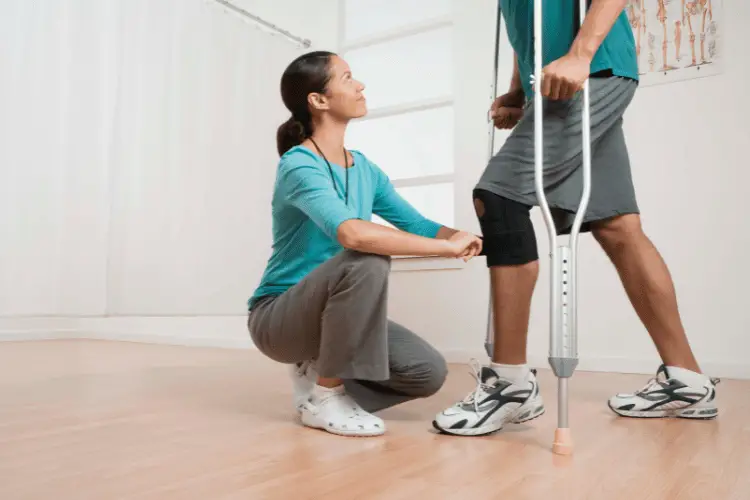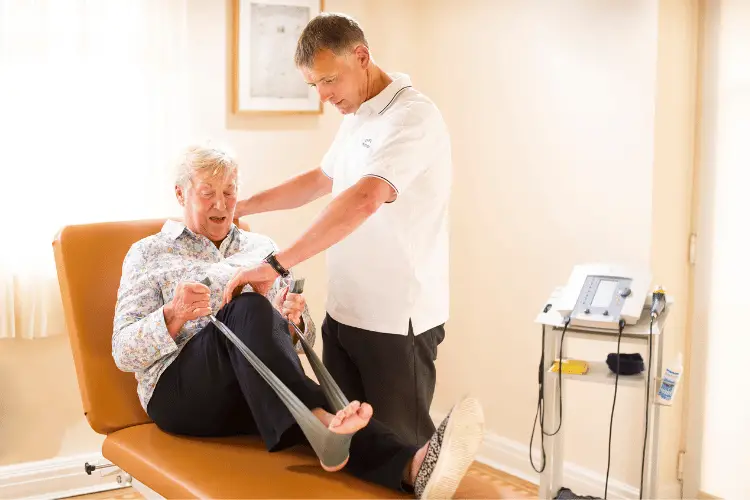A lot of athletes and fitness enthusiasts can find themselves asking this question at one point in their lives: Should I see a personal trainer or a physical therapist? Should I even see both?
Well, the answer may not be as straightforward as you think, as each specialty can handle different aspects of your treatment. In some cases, both can deal with the same concern, but that doesn’t always work for everything.
To give you all the necessary details, I wrote this guide to help you understand the difference between a personal trainer vs. physical therapist and when to see each. Let’s dive in.
Ideally, experts recommend that you see both a personal trainer and physical therapist because they complement each other in many ways. Still, there are several instances where visiting one is enough.
Personal Trainer vs. Physical Therapist: A Thorough Comparison
First off, let me give you a brief introduction to each profession since a lot of people make the mistake of using them interchangeably. Below, we’ll be comparing aspects such as education, training field, and knowledge.
Education
The first main point of difference between these two occupations is education.
Personal Trainers
A personal trainer doesn’t need a degree from an accredited education program, as it’s a self-regulated profession. In other words, anyone can be a personal trainer because the job doesn’t have specific educational requirements.
Of course, many personal trainers already have undergraduate or postgraduate degrees, while others take the route of certification and advanced training to boost their reputability and have more job opportunities.

Most gyms settle for a personal training course in order to hire a personal trainer. Some high-end businesses require personal trainers to get a certification through an accredited agency, such as the National Academy of Sports Medicine.
Some personal trainers like to go the extra mile and pursue careers in specific fields. These include group training, bodybuilding, senior fitness, weight loss, and many more.
Physical Therapists
On the other hand, a physical therapist is a licensed healthcare professional that must get a Doctor of Physical Therapy degree from an accredited school or education program. Usually, it takes anywhere from 3–5 years to earn this degree (after earning an undergrad degree).
After their degree, physical therapists must complete the National Physical Therapy Examination as well as other tests required by the state they intend to practice in.
Then, to keep their license intact, they have to finish a certain number of hours of continuing education specified by their state every couple of years.
How They Train Clients
More importantly, the way that each professional does their job is slightly different:
Personal Trainers
A personal trainer usually works with clients individually or with small groups to help them reach fitness goals. But if the client has an injury or a health condition that makes it hard to perform exercises as they should, a personal trainer will have to refer them to a physical therapist first.
If they’ve been cleared by a physical therapist to continue their healing journey with a personal trainer, only in that case are they allowed to go back!
Other responsibilities of a personal trainer include (but aren’t limited to):
- Assessing a client’s fitness level by monitoring their performance during a short workout to judge their endurance, strength, and more
- Instructing clients on the right and safe use of workout equipment and proper form during various exercises
- Designing exercise programs to help clients reach their fitness goals
- Supporting, motivating, and encouraging individuals in order to reach fitness-related milestones (running a marathon, participating in a famous fitness challenge, etc.)
- Taking body composition measurements and using them to model personalized exercise and weight loss schedules
Physical Therapists
Due to their specialized education, physical therapists have many qualifications that personal trainers don’t. In fact, a physical therapist can also be a personal trainer, but the other way around isn’t possible.
Physical therapists have the following qualifications:
- Diagnosing and evaluating movement in patients
- Diagnosing injuries and movement-related health conditions
- Prescribing a rehabilitation program
- Designing a full-fledged treatment schedule for athletes and other clients
The scope of a physical therapist’s training is much wider than that of a personal trainer’s because the former is a licensed healthcare professional. A physical therapist is an expert in movement-related issues, and they’re an essential part of the treatment of countless disorders, such as:
- Sports injuries
- Back and neck pain
- Joint injuries and conditions (dislocations, osteoarthritis, fractures, breaks, sprains and strains, and more)
- Post-surgical healing
- Age-related issues

After carefully performing tests to assess the patient’s condition and reviewing their medical history, a physical therapist develops a customized treatment plan. Treatment options may include:
- Hands-on exercises and stretches
- The use of different tools and pieces of equipment to improve flexibility, strength, and mobility (resistance band, suspension training unit, functional training machine, exercise ball, treadmill, etc.)
- Procedures (laser therapy, heat or cold therapy, electrical muscle stimulation, ultrasound, and more)
Knowledge
Lastly, personal trainers and physical therapists have knowledge areas that are pretty different, but they often overlap.
Personal Trainer
A personal trainer is well-informed when it comes to the proper technique and form of various workouts, how to use exercise machines, how to lose weight based on each person’s body measurements, etc.
If a personal trainer is specialized in a certain area of expertise, they’ll also have additional, concentrated knowledge in that field. For example, someone who’s taken a weight loss specialty certification is the best candidate for clients who are struggling to shed some stubborn pounds.
Physical Therapist
On the contrary, physical therapists have clinical, intricate knowledge of the musculoskeletal system and joint biomechanics. They most likely took a class in college which involved dissecting human cadavers to learn human anatomy. Personal trainers don’t get this in-depth.
Through this extensive background in how the human body should ideally work, their main goal is to help their patients get as close as possible to their optimal body functions.
Whether a person needs to be able to perform a simple everyday task like picking up a grocery bag or work toward a more complicated goal like running a 5K, a physical therapist is qualified to help with both types of goals.
When to See a Personal Trainer
By now, you should have a better understanding of a personal trainer’s responsibilities.
To further help you make your decision, here are a few scenarios where I recommend you see a personal trainer instead of a physical therapist.
1. When You’re Not Seeing Results When Working Out
There’s nothing easier than hitting the gym and starting your fitness journey. However, when you fail to see any results in your form, strength, flexibility, muscle mass, or weight loss, it may be time to hire a personal trainer.
They’ll be able to tailor a workout program for your individual needs, correct your exercise mistakes, help you stay motivated throughout your routine, and provide educated advice.
Also remember that a personal trainer can shed new light on your workouts, which can ultimately boost your performance to levels you haven’t witnessed before.
2. When You’re Training for a Certain Event or Challenge
Whether you’re preparing to run a marathon or participate in a Tough Mudder race, you need a personal trainer to guide you through the prep phase.
Due to their extensive knowledge, they’ll formulate a training plan before the event to boost your stamina, work on your weak points, and prepare you for the big day.
3. When You Have a Specific Injury (After Seeing a Doctor or Physical Therapist)
When recovering from an injury or surgery, your doctor or physical therapist may encourage you to exercise your body in order to properly heal. In this case, a personal trainer can be the best candidate to accompany you on your journey.
This is especially the case if the trainer is already specialized in training people with certain injuries. After carefully assessing your condition, they’ll create a fitness plan that works on areas of your body without risking re-injury.
4. When You Need a Professional to Supervise You During Workouts

Even if you know how to use different workout machines or how to perfectly lift weights, some people tend to be self-conscious about their forms. They constantly need someone to check if they’re on the right track.
A personal trainer is the right option to keep an eye on your performance and progress during workouts to give you peace of mind. They’ll also ensure your safety in case you’re lifting very heavy weights, for example.
5. When You Want to Work at Home
Not everyone has free time to go to the gym regularly (especially if it’s far from where they live), which is why hiring a personal trainer for at-home workouts can be a great idea.
They’ll recommend the best pieces of workout equipment to buy for home use, instruct you on how to do different workouts on your own, and change your exercises often to fend off boredom.
Other cases where it’s better to see a personal trainer include:
- When you’re completely new to the fitness world and not sure where to begin
- When you need constant motivation
- When you want to challenge yourself
- When you’re bored with repetitive workouts and want an always-changing workout plan
When to See a Physical Therapist
Alternatively, these cases are when experts advise you to visit a physical therapist:
1. When You Have a Dull, Recurring Pain or Lingering Pain
Lingering pain or recurring pain after physical exertion are two major signs that you’re better off seeing a physical therapist.
It doesn’t matter whether you’re healing from an injury or just suffering from continuous pain after a workout. If the ache doesn’t go away after resting for 3 days and applying a cold press, it’ll be time to consult a physical therapist.
2. When Medications Don’t Work
If you have pain or discomfort that no longer goes away after taking pain medications (even if it’s a mild ache), we also suggest you see a physical therapist.
Sometimes, that could be an early indication of an underlying issue that needs addressing.
3. When Recovering From an Injury, Trauma, or Surgery
After an injury, several traumas to muscles and joints, or undergoing surgery, your doctor will likely ask you to get in touch with a physical therapist. They should help you with any movement-related issues, or they could be a crucial part of your treatment journey.
In other cases, you may be completely done with your treatment program but wish to see a physical therapist to ensure you heal properly.
4. When You’re Facing Trouble With Your Mobility
You don’t have to be in pain or recovering from an accident to see a physical therapist. Sometimes, the way you move is uncomfortable or you find yourself not using your limbs the way you used to.
You know your body more than anyone, which is why it’s wise to take your mobility concerns to a physical therapist if you feel like there’s something wrong with your movements.
When to See Both a Personal Trainer and Physical Therapist
A personal trainer and physical therapist complete each other in most cases.
If you have a health issue related to your movement, you must visit a therapist first to work on that condition. They might even refer you to a physician, depending on your health concern.
Then, while the therapist will be responsible for clinically treating you, a personal trainer can come in to ensure you’re able to work out properly regardless of your injury.
They’ll also be able to help if you have a certain fitness goal in mind, whether it’s improving your endurance and strength, losing weight, running a marathon, or simply staying in shape.
Final Words
It can be a bit confusing for people outside the fitness and healthcare industry to determine when to see a personal trainer and when to visit a physical therapist.
I hope this article gave you an in-depth explanation of the expertise and training scope of these two professions so that you’re able to make a well-informed decision about your physical health.
References
- https://www.apta.org/your-career/careers-in-physical-therapy/becoming-a-pt#:~:text=To%20practice%20as%20a%20physical,programs%20is%20typically%20three%20years.
- https://www.dignityhealth.org/conditions-and-treatments/orthopedics/common-joint-injuries-and-conditions
- https://my.clevelandclinic.org/health/articles/12254-musculoskeletal-system-normal-structure–function#:~:text=Your%20musculoskeletal%20system%20includes%20bones,problems%20with%20movement%20and%20function.
- https://musculoskeletalkey.com/joint-anatomy-and-basic-biomechanics/#:~:text=Therefore%20biomechanics%20concerns%20the%20interrelations,to%20deform%20or%20to%20move.
- https://www.ncbi.nlm.nih.gov/pmc/articles/PMC3441783/
- https://www.verywellfit.com/workout-boredom-busters-3495594
- https://www.verywellfit.com/how-to-use-weight-machines-and-gym-equipment-4153575
- https://www.cdc.gov/niosh/emres/longhourstraining/injuries.html
- https://www.verywellfit.com/build-and-improve-stamina-5085005


